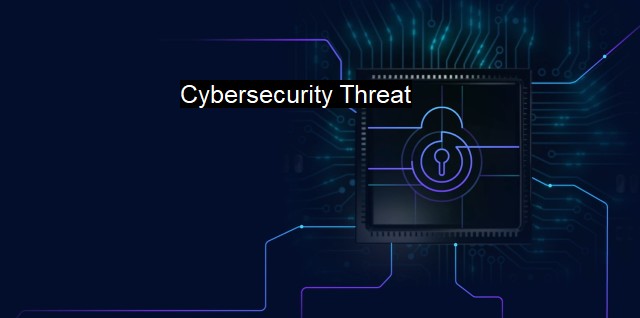What is Cybersecurity Threat?
Protecting Your Systems and Data: Understanding the Threat Landscape of Cybersecurity and the Role of Antivirus Software
Cybersecurity threats refer to the potential dangers that can compromise the security of a computer system, network, or data. These threats typically originate from the Internet, breaching cyber defenses, and exploiting vulnerabilities to gain unauthorized access, steal sensitive data, or disrupt digital lives. Due to rapid digitalization and increasing dependency on technology, cyber threats are pervasive and increasing at an alarming rate.Different types of cybersecurity threats exist, each varying in approach, impact, and severity. Malware is a broad category of harmful software including viruses, which can self-replicate and spread across files or computers, and trojans, which are malicious programs disguised as trustworthy applications. Both are usually spread through spam emails or harmful websites, taking advantage of the user's lack of awareness.
Another common cybersecurity threat is the Human-operated ransomware. Attackers using this method manually infiltrate targeted networks, spread their reach, and carry out hands-on-keyboard attacks that cripple an organization and provide ransom opportunities. Ransomware encrypts data on a user’s system and demands ransoms to release the encryption.
Phishing is a socio-technical threat technique. Usually, it involves sending seemingly legitimate emails or messages which encourage potential victims to reveal personal information, such as login credentials, social security numbers, or credit card details. These attacks are often sophisticated, appearing to originate from trusted sources, such as reputable companies or known individuals.
Notably, Distributed Denial of Service (DDoS) represents a mighty cybersecurity threat, where multiple compromised computers are used to flood a target system with traffic, thereby rendering the target system inaccessible. Often, multiple machines from various global locations are simultaneously coordinated to crash or degrade the target server or network.
Given these threats, cybersecurity efforts are moving to ensure the practice of protecting systems, networks, and programs from digital attacks. This includes implementing security measures like firewalls and antivirus software, as well as user-specific practices like setting strong passwords and recognizing phishing attempts.
Antivirus is vital for any cybersecurity ecosystem because it acts as a frontline defense against most types of malware. Modern antivirus software offers comprehensive protection by scanning, detecting, preventing, and deleting malicious programs, offering crucial real-time protection for the system. They can even block potentially dangerous websites and lock down systems suspected of harboring malware. Antivirus suites have evolved into sophisticated all-purpose security suites, offering safe browsing features, password managers, and personal data protection tools.
Yet antivirus protection alone is not enough to face the evolving threats, as some threats like Advanced Persistent Threats (APTs), which involve sophisticated hackers persistently and silently hitting specific targets, do not rely on traditional malware but on specialized tools and zero-day vulnerabilities undetectable by antivirus. Strengthening user's awareness and machine-learning, artificial intelligence powered solutions are making significant breakthroughs in cybersecurity.
In this rapidly developing landscape, organizations need to implement multi-layered cybersecurity strategies, including employee training, regular security audit, robust back-up practices, and response plan for breaches. Individuals also need to perpetually practice vigilance in their digital footprint, paying attention to what is clicked or downloaded, who is contacted, and how personal information is stored and shared. Strong up-to-date defenses are critical to cybersecurity because threats do not stand still; they evolve and grow, staying intent on capitalizing on any failing in digital security. a comprehensive and proactive approach to cybersecurity is the best defense against the myriad of threats it encompasses.

Cybersecurity Threat FAQs
What is a cybersecurity threat?
A cybersecurity threat is a malicious act that seeks to damage, disrupt, or gain unauthorized access to a computer system or network. Cybersecurity threats can take many forms, including viruses, malware, phishing scams, ransomware, and cyberattacks.What are some common types of cybersecurity threats?
Some common types of cybersecurity threats include viruses, Trojan horses, worms, spyware, adware, ransomware, phishing scams, social engineering attacks, and denial-of-service (DoS) attacks.How can antivirus software protect against cybersecurity threats?
Antivirus software can protect against cybersecurity threats by scanning and analyzing files and programs for known viruses and other malicious code. Antivirus software can also block access to malicious websites, detect and remove malware, and protect against other types of cyberattacks. However, antivirus software is not foolproof and cannot protect against all types of cybersecurity threats.What can individuals do to protect themselves from cybersecurity threats?
Individuals can take several steps to protect themselves from cybersecurity threats, including using strong, unique passwords, keeping antivirus software and other security programs up to date, being cautious when clicking on links or downloading attachments, and avoiding public Wi-Fi networks when accessing sensitive information. It's also important to regularly back up important files and data in case of a cybersecurity attack.| | A | | | B | | | C | | | D | | | E | | | F | | | G | | | H | | | I | | | J | | | K | | | L | | | M | |
| | N | | | O | | | P | | | Q | | | R | | | S | | | T | | | U | | | V | | | W | | | X | | | Y | | | Z | |
| | 1 | | | 2 | | | 3 | | | 4 | | | 7 | | | 8 | | |||||||